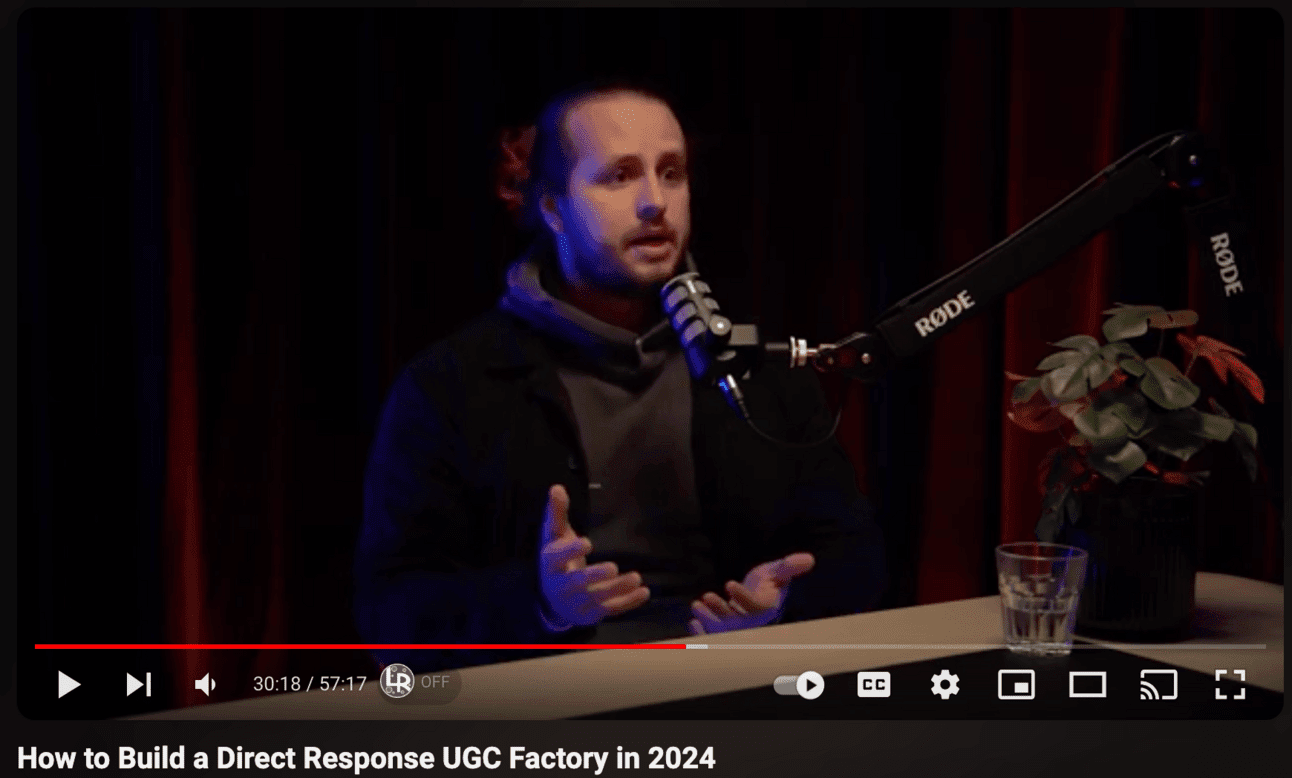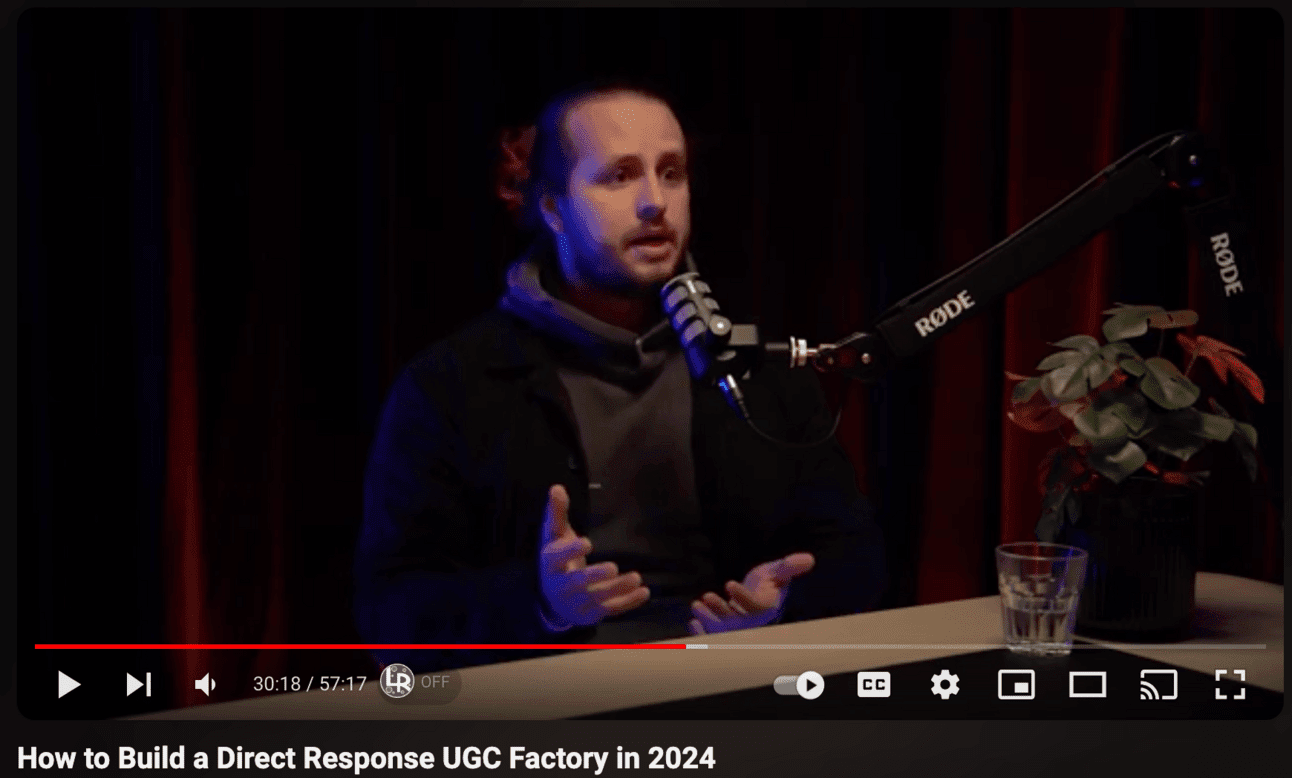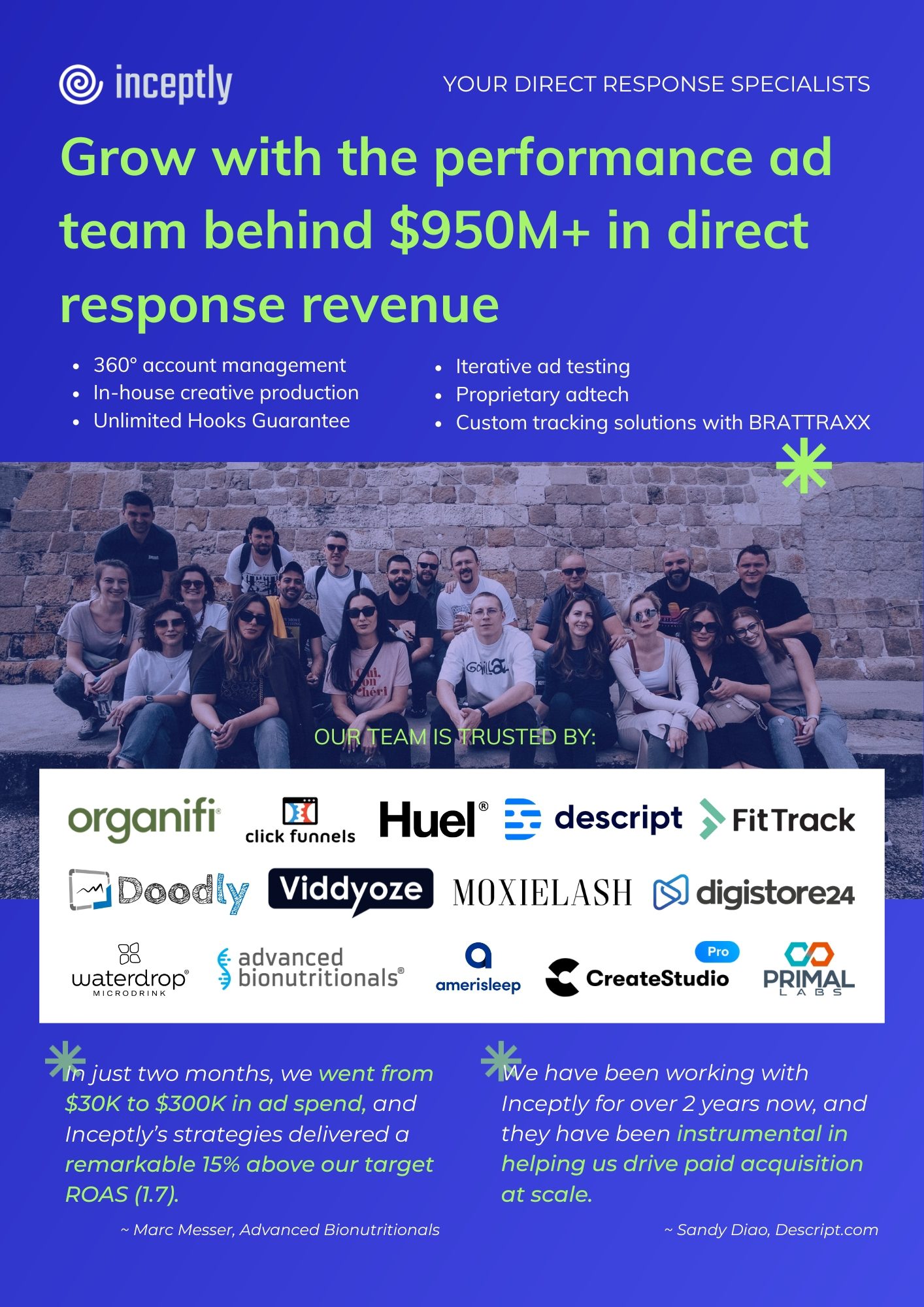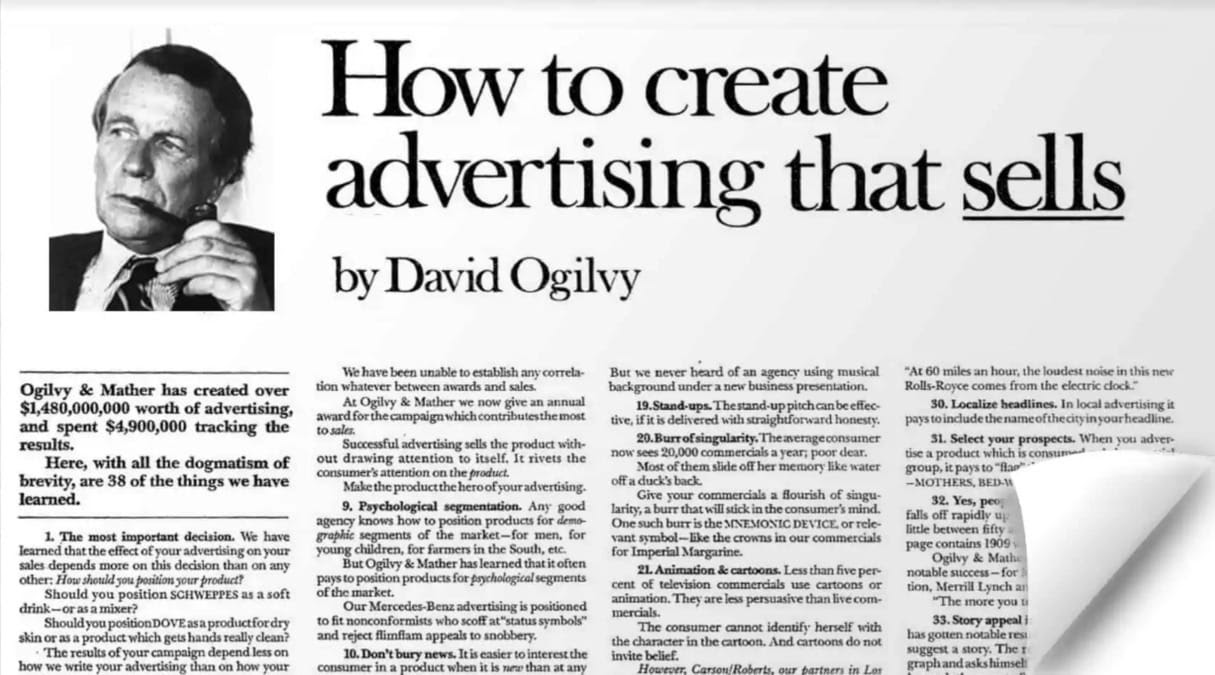New Podcast: How to Build a Direct Response UGC Factory in 2024
Want to see how to build a “hands free” UGC-generating machine that pumps out high-performing, unique Direct Response UGC content that drives scale?
You’re going to want to check out our 57 minute podcast with Sacha Bouhamidi here - it’s all about How to Build a Direct Response UGC Factory in 2024…
…And it’s packed with strategies & tactics you can apply to your business asap.

Watch it here: https://youtu.be/0cO-IAUTM6E
On the podcast you’ll discover:








So if you want to level up your Direct Response UGC game?
Here’s what to do:
1. Watch the Direct Response UGC Factory podcast here (you’ll get a ton of tactical take-aways you can apply to your business asap)
2. Check out the end-to-end “Plug & Play Direct Response UGC Factory” DIY build kit we’ve just opened up for enrollment (closes next Tuesday)
Enjoy!
The VidTao Team
PS - here’s the content email we sent yesterday:
The Promise (and the Problem) with Direct Response User Generated Content…
User Generated Content (UGC) is everywhere, on every ad platform right now.
And done right UGC can be a massive asset to any direct response campaign.
But there’s a big problem with it.
(and we’ll dive into that problem & its implications in just a moment...)
But first, for context…
Let’s step back in time and re-visit some material from one of our favorite marketing heros, David Ogilvy.
Ogilvy would have loved User Generated Content (UGC).
Why?
Have you seen his “How to Create Advertising that Sells” ad?
(Probably the most amazing ad agency ad ever - which is a story for another email...)
Here it is, so first, check it out… (Read it & you’ll definitely pick up some nuggets of wisdom)
If you read Ogilvy’s rules here, you’ll notice how UGC as an ad format checks a lot of these boxes, like
1. Large Promise: Ogilvy emphasized the importance of making a big promise to grab attention. UGC inherently does this by showcasing real-life experiences. When a customer shares how a product remarkably improved their life, it serves as a promise to potential buyers that they can experience the same benefits.
2. Brand Image: Ogilvy knew the power of a strong brand image. UGC contributes to this by providing authentic and relatable content. When consumers see real people vouching for a product, it enhances the brand's credibility and creates a positive image.
3. Big Ideas: According to Ogilvy, advertising should be built around a big idea. UGC can be centered around impactful themes or stories. For example, a brand can launch a campaign where users share their stories of personal transformation using the product. This creates a narrative around the brand and makes the campaign memorable.
4. Don’t be a Bore: Ogilvy believed in keeping the audience engaged. UGC is often created by enthusiastic customers, making it inherently engaging and far from boring. It's real, it's raw, and it's relatable.
5. Innovate: Ogilvy was a proponent of innovation. With UGC, brands have an opportunity to tap into the creativity of their user base. This leads to diverse and innovative content that can capture attention in ways that traditional advertising might not.
6. Psychological Segmentation: Ogilvy talked about tailoring content to specific psychological segments. UGC does this naturally as it comes from a diverse set of individuals, each with different perspectives and values, ensuring that the content resonates with various segments.
7. Don’t Bury News: Ogilvy believed in highlighting the newsworthy aspects. UGC is often the first to highlight new uses or benefits of a product. Brands can leverage this by promoting UGC that sheds light on something new and exciting.
8. Factual vs. Emotional: Ogilvy knew the power of both factual and emotional content. UGC excels in this area, as it can range from factual product reviews to emotional stories of how a product impacted someone's life.
9. “Burr of Singularity”: Ogilvy believed in the power of uniqueness. UGC is inherently unique; each piece is a one-of-a-kind perspective from an individual user. This uniqueness makes it memorable and impactful.
10. Editorial Layout: Ogilvy found that ads resembling editorial content were more effective. UGC often has this quality. It doesn’t look like an ad, which makes it more trustworthy and engaging.
11. Repeat Your Winners: Ogilvy advised repeating what works. When a piece of UGC proves particularly effective, brands can encourage more of the same kind of content, creating a snowball effect.
12. Use Captions to Sell: Ogilvy knew the power of captions. In UGC, especially visual content, captions can provide context and highlight the key selling points of a product. (Kudos to Ryan Magin for defining & continually re-inventing the vertical video / UGC caption game)
Direct Response UGC - when it’s done right - is authentic, relatable, and can deliver insane results.
Want an example?
Case Study: Performance UGC in Action
Again: When you do UGC, the right way? MAGIC happens.
Want proof?
Here’s an example UGC from skincare brand Peter Thomas Roth that led to the brand completely selling out 6 months of product in just one week.*
Here is the UGC from Trinidad Sandoval, a happy Peter Thomas Roth eyecream customer:

What made this UGC video so successful?
Let's analyze this UGC video in light of Ogilvy's rules:
1. Large Promise: Never the forget the power of showing a transformation. Trinidad's video implicitly promises viewers that they can achieve instant results using the eye tightener. Her before/after visual transformation serves as a powerful promise.
2. Brand Image: Although Trinidad didn't mention the brand, the viral video positively impacted Peter Thomas Roth's brand image. The product selling out is a testament to the trust and desire it created among viewers.
3. Big Ideas: The big idea here is instant transformation. Trinidad's video revolves around this central theme, which is simple yet highly impactful.
4. Don’t be a Bore: The video is anything but boring. It's short, to the point, and shows a real-life, relatable experience that keeps viewers hooked.
5. Innovate: The video is innovative in its simplicity. It doesn't use flashy graphics or a scripted pitch. It's just a genuine user showing a product in action.
6. Psychological Segmentation: The video appeals to a specific segment: individuals looking for instant skincare solutions. It addresses their pain points directly.
7. Don’t Bury News: The video doesn't bury the lead. It gets straight to the point, showing the product's effect in real-time.
8. Factual vs. Emotional: The video combines both. The factual aspect is the visible effect of the product, while the emotional aspect is the excitement and authenticity Trinidad brings.
9. Burr of Singularity: The video stands out because of its authenticity and the dramatic results it showcases. It's not a typical ad, and that's what makes it memorable.
10. Editorial Layout: The video doesn't look like an ad. It looks like someone sharing a favorite product. This editorial style makes it more engaging and trustworthy.
To sum up, Trinidad Sandoval's TikTok video is a prime example of how UGC, when aligned with Ogilvy's principles, can be incredibly powerful in direct response advertising.
It's authentic, engaging, and showcases the product's benefits in a real and relatable way. This kind of UGC can drive tremendous engagement and conversions, as evidenced by the product selling out.
But with all that said, there’s still a huge problem with UGC - even this specific UGC that did so amazing…
Direct Response UGC: The Big Problem
Believe it or not, this UGC above is actually a great example of the problem with UGC in general:
The team at Peter Thomas Roth did NOT engineer this piece of content. It was 100% a happy accident.
And for 99% of companies & agencies out there, good UGC is left completely to chance.
They don’t have an in-house system to reliably generate NEW, high-performing UGC.
I’m talking about a full-fledged, scalable system for:
- Coming up with hypothesis / specific UGC ad ideas to test
- Building the right set of instructions that UGC creator can easily follow
- Putting these instructions in front of the right kind of creator who delivers quality content, on time and following instructions
…So that you have a continual stream of new, high-performing UGC creatives to test, iterate and scale with.
Building a Direct Response UGC “Factory”?
But what if you could “implant” a Direct Response UGC “Factory” directly into your company…
…To eliminate the headache of trying to piece together random UGC that stumbles across your plate.
…So you have a system that churns out a steady stream of entirely new high-performing UGC material to test in your ads, each designed from scratch with performance in mind.
That’s what we talked about recently on a live podcast with Sacha Bouhamidi (X: @Sachahbd)

(Watch the 57 minute podcast here - it’s packed with strategies & tactics you can apply to your business asap today)
Sacha steps into companies, builds out the systems and processes for ideating, sourcing and producing high-performance UGC ads on Meta/FB/IG/TikTok/YouTube…
…So that they can massively increase the volume of high quality output, leading to a higher “win rate” & more winning ads.
So if you want to level up your Direct Response UGC game?
Here’s what to do:
1. Watch the Direct Response UGC Factory podcast here (you’ll get a ton of tactical take-aways you can apply to your business asap)
2. Check out the end-to-end “Plug & Play Direct Response UGC Factory” DIY build kit we’ve just opened up for enrollment (closes next Tuesday)
(And if you have any questionson anything else related to Direct Response User Generated Content (UGC)…
Just hit REPLY to this email and let us know. We’ll be talking more about it here in the newsletter over the next few days.
Today's blog post is brought to you by Inceptly
Direct Response Video & Traffic Agency

Are you spending over $1k/day on ads?
Schedule a FREE brainstorm session: inceptly.com/call
Have a great week!
The VidTao Team
PS: Are you spending $1k/day+ on paid ads?
Let’s brainstorm on how to scale with YouTube, Connected TV, and more. 
What are your YouTube ad questions?
In the meantime, what questions do YOU have about YouTube ads?
Let us know in the Comments section below, and we’ll make sure to cover your question in an upcoming post.
Have a nice day!
The VidTao Team


